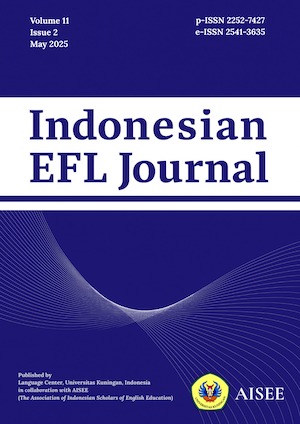L1 AND L2 READING ATTITUDES AND THEIR CONTRIBUTION TOWARD READING HABIT
Abstract
The aims of the study are threefold. The first is to investigate the reading attitudes toward first language (L1) and second language (L2) in an English as a foreign language (EFL) context. The second aim is to find out the correlation between both variables. The last objective of the study is to find out the contribution of L2 reading attitude toward reading achievement. This study involved two sets of questionnaires adapted from Yamashita (2004) and Mikami (2016) and 177 freshmen, sophomore and junior English language education department students. The data revealed that means of reading attitude toward L1 and L2 are not significantly different with 2.60 and 2.65 respectively, and that reading attitude in L1 is strongly correlated with reading attitude in L2 (r = 0.637). An interesting finding of the present study pointed out that although students have positive attitude in L2, it does not automatically motivate them to spend their time reading. External factors such as teachers and specific reading programs both in L1 and L2 seem to play bigger roles in shaping students’ reading attitudes. Pedagogical implications are also discussed
Keywords: Reading attitude in L1; reading attitude in L2; reading habit; external factors.References
Ajzen, I., & Fishbein, M. (1977). Attitude-behavior relation: A theoretical analysis and review of empirical research. Psychological Bulletin, 84(5), 888-918.
Akbari, H., Ghonsooly, B., Ghanzanfari, M., & Shahriari, H. (2017). Attitude toward reading: L1 or L2 or both. SAGE Open, 1-10.
Babayigit, S. (2014). The relations between word reading, oral language, and reading comprehension in children who speak English as a firs (L1) and second language (L2): a multigroup structural analysis. Reading and Writing, 28, 527-544.
Briggs, J. G., & Walter, C. (2016). Read on! Extensive reading and young second language learners' motivation and attitudes. Oxford: University of Oxford Department of Education.
Camiciottoli, B. C. (2001). Extensive reading in English: habits and attitudes of a group of Italian university EFL students. Journal of Research in Reading , 24(2), 135-153.
Edele, A., & Stanat, P. (2016). The role of first-language listening comprehension in second-language reading comprehension. Journal of Educational Psychology, 108(2), 163-180.
Horwitz, E. K., Horwitz, M. B., & Cope, J. (1986). Foreign language classroom anxiety. The Modern Language Journal, 70(2), 125-132.
Iftanti, E. (2012). A survey of the English reading habits of EFL students in Indonesia. TEFLIN Journal, 23(2), 2012.
Kartal, E. (2011). Foreign language teacher trainee's reading attitude. Social Behavior and Personality, 39(3), 345-360.
Katz, D. (1960). The functional approach to the study of attitudes. Oxford Journals, 24(2), 163-204.
Keung, Y.-C., & Ho, C. S.-H. (2009). Transfer of reading-related cognitive skills in learning to read Chinese (L1) and English (L2) among Chinese elementary school children. Contemporary Educational Psychology, 34, 103-112.
Krashen, S. D. (2004). The power of reading: Insights from the research. Westport, CT: Heinemann.
Lee, J., & Schallert, D. L. (2014). Literate actions, reading attitudes, and reading achievement: Interconnections across languages for adolescent learners of English in Korea. The Modern Language Journal, 98(2), 553-573.
Martinez, R. S., Aricak, O. T., & Jewell, J. (2008). Influence of reading attitude on reading achievement: A test of the temporal-interaction model. Psychology in the School, 45(10), 1010-1022.
Masduqi, H. (2014). EFL reading in Indonesian universities: Perspectives and Challenges in Cultural Contexts. Journal of Teaching and Education, 03(03), 385-397.
Mikami, A. (2017). Students' attitudes toward extensive reading in the Japanese EFL context. TESOL Journal, 8(2), 471-488.
Mori, S. (2002). Redefining motivation to read in a foreign languae. Reading in a Foreign Language, 14(2), 91-110.
Nation, I. (2009). Teaching ESL/EFL reading and writing . NY: Routledge.
Onwuegbuzie, A. J., Bailey, P., & Daley, C. E. (2010). Cognitive, affective, personality, and demographic predictors of foreign-languae achievement. 94(1), 3-15.
Pratiwi , P. S. (2018). Minat baca masyarakat Indonesia masih rendah [Indonesian's reading rate still low]. CNN Indonesia. https://www.cnnindonesia.com/gaya-hidup/20180326160959-282-285982/minat-baca-masyarakat-indonesia-masih-rendah.
Sparks, R. L., Patton, J., Ganschow, L., & Humbach, N. (2012). Do L1 reading achievement and L1 print exposure contribute to the prediction of L2 proficiency? Language Learning, 62(2), 473-505.
Yamashita, J. (2004). Reading attitudes in L1 and L2, and their influence on L2 extensive reading. Reading in a Foreign Language, 16(1), 1-19.
Yamashita, J. (2007). The relationship of reading attitudes between L1 and L2: An investigation of adult EFL learners in Japan. TESOL Quarterly, 41(1), 81-105.









